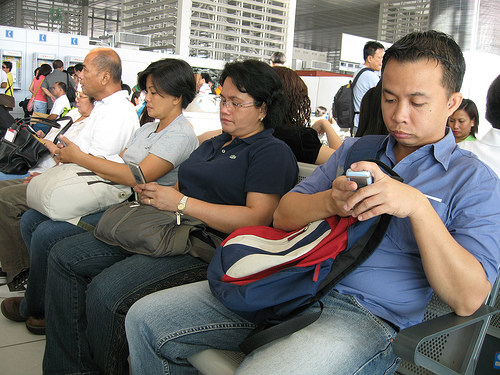Self Care – Forward-Head Posture
Table of Contents
- Activities to Avoid or Change
- For Temporary Relief
- Stretches and Exercises for Longer-Lasting Relief
- Yoga Corner
Activities To Avoid or Change:


Forward-Head Posture (FHP) is also known as iHunch or iPosture because it is so often created by texting.
Keep your hips against the back of the chair while sitting for long periods.
The guy on this end of the picture is the worst but it isn’t just that his head is forward. The woman next to him also has her hips pulled forward to accommodate her (less severe) FHP. This is even more common while driving. Many people pull their hips forward to accommodate FHP and then create problems in their low back and hips.
Improve the ergonomics
at your home or office.
This post offers some great ideas for actively sitting without support or sitting with supports that help you avoid pain and fatigue. There are also suggestions about a few useful accessories.
Stop over-stretching the base of your neck in the back. Many people pull on their head because it feels good. It only helps for a short period and makes the problem worse. Overstretching weakens those muscles that are needed to pull your head back over your shoulders.
Stop over-stretching the base of your neck in the back. Many people pull on their head because it feels good. It only helps for a short period and makes the problem worse as it weakens those muscles that are needed to pull your head back over your shoulders.
If you just did one thing…
These chin tucks are the common recommendation for making gentle changes FHP.
You can do them at your desk. Or, you can do them against the wall. Try them with a sustained hold or try them with AIS guidelines.
They’re easy and effective. You can learn more about them in this post. That post also has some follow-up exercises that create a more complete approach to correcting FHP.
These self-care activities, like over-the-counter drugs, are not intended to replace appropriate medical attention. If you have concerns about these self-care activities, get help from a professional. Use these suggestions and strategies with discretion and at your own risk. See your doctor when your pain is severe, persistent, or not responding to these simple suggestions.
Stretches and Exercises for Longer-Lasting Relief:
This is a gentle, easy way to relax the entire neck and balance your head on your shoulders. Loosen the muscles at the top of your neck, in the back with stretches #1, #2 and #3. Stretches #6, #7 and #8 are key for opening the flexion at the bottom on your neck. Now that it works from front-to-back, follow through with stretches #9 and #10 to lengthen the sides. It will lengthen the SCM so that it doesn’t keep pulling you back into FHP.
This post has gentle breathing exercises that get your ribs working better to support a heathier breathing pattern. Focus on laying with your neck lengthened and your chin tucked to reverse FHP.
If you have rounded shoulders and a little too much curve in your upper back, these doorway stretches are easy and effective. Just a few moments here and there through your day can make noticeable difference in slumped shoulders that support FHP.
For people who are diligent with self-care:
This 3 pack of yoga wheels helps to mobilize and reshape your spine. I use a 3-pack like this regularly to loosen my back and recommend them to clients that like self-care activities at home.
2-3 times a week, do exercises that drive your elbow up and back. Rowing. Shoulder presses. Upright rows. Posterior Flyes.
A common strategy is to do 5 sets about a minute apart. This will help to strengthen the muscles that pull your shoulders back.
Forward-Head Posture is often chronic and can lead to more complicated health problems. In that case, An experienced bodyworker can be very helpful in dealing with underlying structural problems and managing your progress.
Support Integrative Works to
stay independent
and produce great content.
You can subscribe to our community on Patreon. You will get links to free content and access to exclusive content not seen on this site. In addition, we will be posting anatomy illustrations, treatment notes, and sections from our manuals not found on this site. Thank you so much for being so supportive.
Cranio Cradle Cup
This mug has classic, colorful illustrations of the craniosacral system and vault hold #3. It makes a great gift and conversation piece.
Tony Preston has a practice in Atlanta, Georgia, where he sees clients. He has written materials and instructed classes since the mid-90s. This includes anatomy, trigger points, cranial, and neuromuscular.
Question? Comment? Typo?
integrativeworks@gmail.com
Follow us on Instagram
*This site is undergoing significant changes. We are reformatting and expanding the posts to make them easier to read. The result will also be more accessible and include more patterns with better self-care. Meanwhile, there may be formatting, content presentation, and readability inconsistencies. Until we get older posts updated, please excuse our mess.